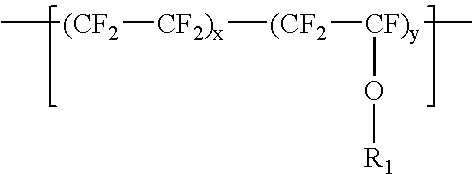Polyimide based compositions useful as electronic substrates, derived in part from (micro-powder) fluoropolymer, and methods and compositions relating thereto
a technology of polyimide and composition, applied in the direction of non-metallic protective coating application, coupling device connection, synthetic resin layered product, etc., can solve the problems of reducing product consistency and mechanical performance, and affecting the effect of chemical composition
- Summary
- Abstract
- Description
- Claims
- Application Information
AI Technical Summary
Benefits of technology
Problems solved by technology
Method used
Image
Examples
examples 1 – 5
EXAMPLES 1–5
[0230]A slurry was prepared consisting of three components, a polyamic acid, a fluoropolymer micro powder and a polar solvent. 40 grams of dimethylacetamide solvent was added to a blender. ZONYL® Micronized Powder was hammer milled and sieved through both a 325 and 400-mesh screen filter to form micro powder derived from MP-1600. After the MP-1600 in “micro powder” was formed, 10 grams were weighted and added to the blender containing the solvent. The blender was started at low speed for 1 minute then increased to high speed for an additional minute. Ten grams of a 20 weight percent polyamic acid solution, dissolved in dimethylacetamide, was added to the blender and stirred for one minute. The polyamic acid solution was derived from a diamine and a dianhydride. In this case, the diamine was 4,4′-ODA and the dianhydride was PMDA.
[0231]Next, a high-viscosity polyamic acid solution was prepared using the same two monomers. First, a low-viscosity polyamic acid (about 50 pois...
examples 6 – 10
EXAMPLES 6–10
[0238]EXAMPLES 6–10 were prepared in accordance with EXAMPLES 1–5. However, in these EXAMPLES, the fluoropolymer resin micro powder was derived from ZONYL® MP-1100 instead of MP-1600.
[0239]MP-1100 is a lower molecular weight “micronized” powder compared to MP-1600. Again, the polyamic acid prepared for both the fluoropolymer slurry and the high-viscosity polyamic acid was derived from substantially equimolar amounts of 4,4′-ODA and PMDA. The portions are described in Table 3.
[0240]
TABLE 3Fluoropolymer micro-powder fillerloading and material balance sheetFinalPolyamicFilm Conc.AcidLoading ofSlurry Portion Breakdown20 weightfluoropolymerMicro powder20 weightpercentmicro powderderived from% polyamic highin polyimideZONYL ®acid from viscosity(wt. %)MP-1100 (g)DMAc (g)slurry (g)acid (g)20 (E-6)10401019030 (E-7)17.268.61019040 (E-8)26.7106.71019050 (E-9)401601019060 (E-10)6024010190
The following results were measured for EXAMPLES 6–10.
[0241]
TABLE 4Selected properties of PMDA / ...
examples 11 – 17
EXAMPLES 11–17
[0242]EXAMPLES 11–17 were prepared in accordance with EXAMPLES 1–5, however the monomers used to prepare the high-viscosity polyamic acid were altered. Instead of using and equimolar ratio of 4,4′-ODA and PMDA, three monomers were used.
[0243]In these EXAMPLES, a mixture of pyromellitic dianhydride (PMDA) and oxydiphthalic anhydride (ODPA) was used as the dianhydride component and an equimolar amount of APB-134 (aminophenoxybenzene) was used as the diamine component.
[0244]The resultant polyimide (i.e. a polyimide without a fluoropolymer component at all) would have a glass transition temperature in the range of about 210° C. to 240° C. and would be considered a thermoplastic polyimide. This polyimide is in stark contrast to a polyimide derived from 4,4′-ODA and PMDA having a glass transition temperature over 400° C. The polyamic acid used for the slurry preparation was derived from 4,4′-ODA and PMDA.
[0245]The fluoropolymer component for these EXAMPLES was maintained at ...
PUM
| Property | Measurement | Unit |
|---|---|---|
| melting temperature | aaaaa | aaaaa |
| melting temperature | aaaaa | aaaaa |
| melting temperature | aaaaa | aaaaa |
Abstract
Description
Claims
Application Information
 Login to View More
Login to View More - R&D
- Intellectual Property
- Life Sciences
- Materials
- Tech Scout
- Unparalleled Data Quality
- Higher Quality Content
- 60% Fewer Hallucinations
Browse by: Latest US Patents, China's latest patents, Technical Efficacy Thesaurus, Application Domain, Technology Topic, Popular Technical Reports.
© 2025 PatSnap. All rights reserved.Legal|Privacy policy|Modern Slavery Act Transparency Statement|Sitemap|About US| Contact US: help@patsnap.com



